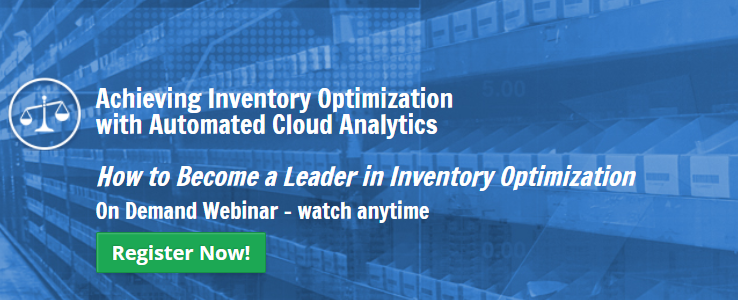With the world once again in the grip of Jedi-mania, we can take a moment to think about what special powers are needed to turn an ordinary inventory professional into an Inventory Optimizer.
There’s a lot to know
Proficiency in the inventory arts requires mastery of a great deal of knowledge: Product knowledge, knowledge of suppliers and customers, teamwork skills, and a visceral understanding of the stochastic dynamics of inventory demand. One of the most fundamental types of knowledge is corporate self-knowledge, especially knowing where you want your organization to go.
How to know it
So much of that knowledge rests on an understanding of operational information: How to gather it, interpret it, and discern its implications. Most of that information is in the form of hard numbers, usually too many to absorb without computer help. Some of it comes from conversations with customers and suppliers, which let you know where they want their organizations to go and how you figure into their plans. Blending large quantities of numbers with knowledge of everybody’s goals and intentions provides situational awareness.
How to use the knowledge
Situational awareness must be translated into detailed operational decisions for every inventory item. For each item, you must decide on an inventory policy: As inventory decreases, at what point should we order more? How much more? How do we respond to stockouts?
In the good old days, these decisions were usually made based on gut instinct. You might say, or hope, that these decisions were guided by The Force. Unfortunately, what the good old days often bequeathed the present day was nothing more than a mish-mash of incoherent and dysfunctional policies. If there is “no try, only do or not do”, then the history of inventory management has seen a lot of not do.
Rather than hoping for mystical inspiration, the way forward is to systematically organize all that information into accurate, comprehensive probability models of inventory dynamics. Such models can relate all the key levers of performance to key performance indicators (KPI’s).
How software analytics can help
Software analytics can relate key drivers of performance to performance metrics. Key drivers include reorder points or min’s, order quantities or max’s, replenishment lead times, and the level and variability of demand. Also important are the costs of holding, ordering and running out of inventory. Using numerical values for these key inputs, inventory software can estimate the corresponding values of service level, fill rate, inventory operating costs and total inventory capital investment. In other words, the software can convert design decisions into consequences.
Now, some decisions might be a bit misguided, with consequences that are not appealing. Then the software becomes not just an analysis tool but a design tool. That is, it lets you play around a bit, exploring different decisions and hunting for system designs that yield better results.
This is where reliance on The Force reappears in practice, because you are left using the software to help you intuit your way to good system designs. We call this “hunt and peck optimization”. It amounts to a guessing game in which you try changing one or more of the drivers to see whether the KPI’s get better or worse.
The most advanced inventory software can take you to the next level. It is inventory optimization software. It eliminates the guesswork by automating the search through the very large “design space” to find desirable system designs for all your items.
For instance, you might ask the software to find that combination of reorder point and order quantity that minimizes the total cost of managing an item (i.e., the sum of holding, ordering and shortage costs) while insuring that the chance of a stockout is tolerably low. Even if your Jedi powers would eventually lead you to the same design, do you really want to whack your way through all 20,000 items you are managing? Let R2D2 figure it all out: That’s what droids are for.
Why we still need our light sabers
Despite all the productivity gains by inventory optimization software, you may still feel the need to take light saber in hand and finish off the design of inventory policy for selected items. You may want to do this for several reasons.
One is to see how sensitive the optimal design is to slight changes. For example, the most efficient designs might require more orders than your purchasing department can comfortably handle in one year. So you might want to see how much performance deteriorates if you make a practical concession and specify a larger order quantity.
There are key differences between this kind of “post-optimality” analysis and the old-fashioned hand-crafting of individual inventory policies. For one, the starting point is a very smart design, not a guess. For another, you can pick and choose the items that get your personal attention, assured that all the rest are well provided for.
Related Posts

Managing Spare Parts Inventory: Best Practices
In this blog, we’ll explore several effective strategies for managing spare parts inventory, emphasizing the importance of optimizing stock levels, maintaining service levels, and using smart tools to aid in decision-making. Managing spare parts inventory is a critical component for businesses that depend on equipment uptime and service reliability. Unlike regular inventory items, spare parts often have unpredictable demand patterns, making them more challenging to manage effectively. An efficient spare parts inventory management system helps prevent stockouts that can lead to operational downtime and costly delays while also avoiding overstocking that unnecessarily ties up capital and increases holding costs.

12 Causes of Overstocking and Practical Solutions
Managing inventory effectively is critical for maintaining a healthy balance sheet and ensuring that resources are optimally allocated. Here is an in-depth exploration of the main causes of overstocking, their implications, and possible solutions.

FAQ: Mastering Smart IP&O for Better Inventory Management.
Effective supply chain and inventory management are essential for achieving operational efficiency and customer satisfaction. This blog provides clear and concise answers to some basic and other common questions from our Smart IP&O customers, offering practical insights to overcome typical challenges and enhance your inventory management practices. Focusing on these key areas, we help you transform complex inventory issues into strategic, manageable actions that reduce costs and improve overall performance with Smart IP&O.











